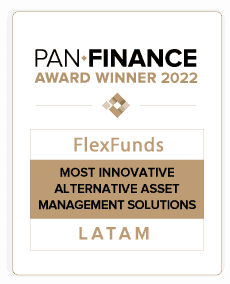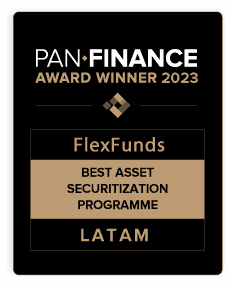- This article details the alternative assets chosen by portfolio managers to diversify and achieve better long-term returns.
- The information, extracted from the II Annual Report of the Asset Securitization Sector 2024-2025, developed by FlexFunds in collaboration with Funds Society, is aimed at portfolio managers and investment advisors looking to diversify beyond classic assets such as bonds and stocks.
- At FlexFunds, we provide asset securitization solutions to issue exchange-traded products (ETPs) that can be launched to the market within 6 to 8 weeks. For more information, feel free to contact our team of experts.
The most sophisticated investment portfolios are increasingly incorporating alternative assets that do not align with traditional categories, such as stocks, bonds, or cash. This shift in portfolio composition is primarily driven by three fundamental reasons:
- Reduction of volatility impact: Alternative assets have a low correlation with traditional financial markets, helping to reduce overall portfolio volatility. By not depending on the behavior of equity or fixed-income markets, these assets allow for smoother market fluctuations and protect capital during periods of economic uncertainty.
- Access to higher returns and unique opportunities: These assets offer the potential for higher returns through investments not available in traditional markets, such as real estate, private equity, hedge funds, and structured products, which can provide a more attractive risk-adjusted return in the long term.
- Enhanced portfolio diversification: While alternative assets have drawbacks such as lower liquidity, greater opacity in terms of transparency and regulation, and higher fees, they continue to gain relevance in building investment portfolios due to their ability to diversify sources of return and offer a different risk profile compared to traditional assets.
The most included alternative assets in portfolios
However, not all assets in this class cover every investment portfolio. In the II Annual Report of the Asset Securitization Sector 2024-2025, developed by FlexFunds in collaboration with Funds Society, asset managers indicated their preferences in this area:
Real estate
Firstly, 39% of the managers surveyed stated that they include real estate as alternative assets in investor portfolios. In this case, the investment provides stable and recurring income, potential capital appreciation, and lower volatility compared to stock markets.
Additionally, during times of economic uncertainty, real estate may act as a safe haven for value.
Private equity
Meanwhile, 29% of specialists reported allocating their portfolios to private equity funds, which, while carrying higher risks and lower liquidity due to long-term horizons, also offer higher returns.
Digital assets
Additionally, 10% of portfolio managers include digital assets as alternatives. The choice of this group, which can include cryptocurrencies, reflects a willingness to invest in emerging technologies and highly volatile assets that, in exchange for higher risk, can offer significant returns.
Hedge funds
Furthermore, 7% indicated using alternative investments such as hedge funds and Commodity Trading Advisors (CTAs) because they provide active and sophisticated strategies to generate positive returns in various market conditions, particularly through the use of financial derivatives.
Other
The report, which considered the opinions of executives from 100 financial sector companies across 18 countries, revealed that 15% include other types of assets and strategies in their alternative asset allocations, different from those mentioned above.
Figure 1: Alternative products in the portfolio
What percentage is allocated to alternative assets?
The II Annual Report of the Asset Securitization Sector 2024-2025 by FlexFunds and Funds Society also provided details on the percentage of expert-managed portfolios focused on alternative assets beyond bonds, stocks, or cash.
Specifically, 43% of respondents allocate up to 20% to these assets, while 20% allocate less than 10%, and only 17% allocate more than 30%.
However, 23% of managers are unaware of the specific figure. Overall, 61% allocate up to 30% to alternative assets.“The decision to allocate capital to alternative assets and the amount invested depends on the risk tolerance and sophistication of the investors. These assets, as they involve higher risks than traditional ones, are more suitable for aggressive risk profiles,” the report stated.
The disruption of digital assets
Although only 10% of managers choose digital assets to diversify investor portfolios, it is worth highlighting how this category is composed due to its innovation.
Within the wide variety and possible combinations of digital assets, cryptocurrencies such as Bitcoin (BTC) and Ethereum (ETH) stand out, either directly or through their exchange-traded funds (ETFs), along with others such as Cardano (ADA), Ripple (XRP), Polkadot (DOT), and Chainlink (LINK). There is also room for the popular non-fungible tokens (NFTs).
On the other hand, among those who do not include digital assets in their alternative asset strategies, 39% mentioned that it is due to the high volatility and risk they involve. Of this group, 17% cited a lack of knowledge, and 12% mentioned other reasons, such as lack of regulation, or the client’s reluctance to invest in them.
Figure 3: Types of digital assets in the portfolio
“However, there are signs of interest in these types of assets, and it is likely that future allocations in portfolios will increase as more knowledge and experience with them is gained,” clarified the report’s authors.
It is worth noting that the II Annual Report of the Asset Securitization Sector 2024-2025 by FlexFunds and Funds Society can be easily downloaded for free in just a few clicks.








